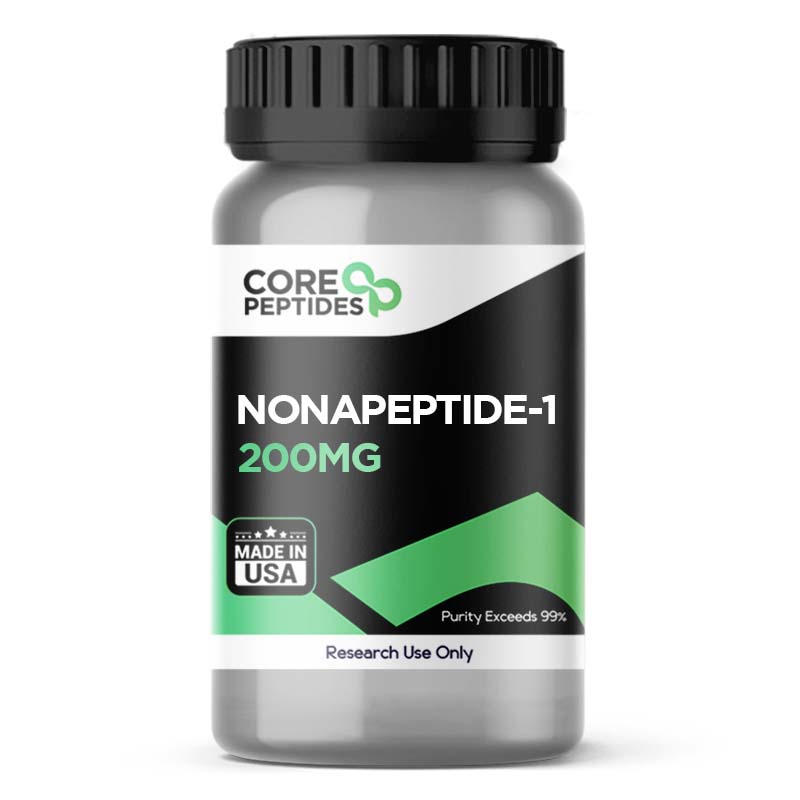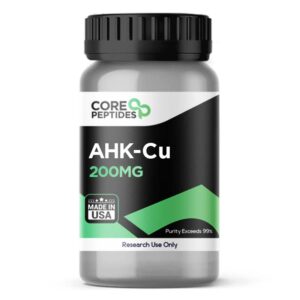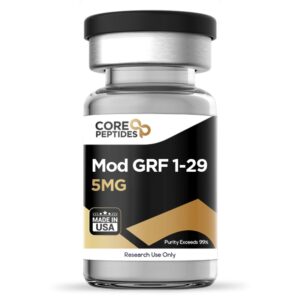Description
Nonapeptide-1 – Research Grade | Cloud Pharmacy
Size: 5mg
Form: Lyophilized Powder
Purity: ≥99%
Storage: Store at -20°C
Molecular Formula: C₆₁H₈₇N₁₅O₉S
Molecular Weight: 1206.5 g/mol
Other Names: Melanostatine-5, Melanocortin Antagonist Peptide
Description
Nonapeptide-1 is a synthetic peptide composed of nine amino acids, developed in the 1990s as part of a research effort to identify antagonists of the melanocortin-1 receptor (MC1R). This receptor plays a key role in melanin biosynthesis, the process responsible for pigmentation in the skin, hair, and eyes.
Early findings indicate that Nonapeptide-1 may act as an MC1R antagonist, potentially inhibiting the binding of α-melanocyte-stimulating hormone (α-MSH) to melanocytes, thereby reducing tyrosinase activity — the rate-limiting enzyme in melanogenesis. Through this mechanism, researchers hypothesize that Nonapeptide-1 may decrease melanin synthesis and reduce hyperpigmentation in laboratory models.
Due to these potential actions, Nonapeptide-1 has become a subject of significant research interest in dermatological, cellular, and molecular studies, particularly for its theoretical role in skin pigmentation regulation, photoprotection, and melanocyte signaling pathways.
Chemical Makeup
-
Sequence: Met–Pro–D-Phe–Arg–D-Trp–Phe–Lys–Pro–Val–NH₂
-
Molecular Formula: C₆₁H₈₇N₁₅O₉S
-
Molecular Weight: 1206.5 g/mol
-
Peptide Type: Nonapeptide (9 amino acids)
Research and Clinical Findings
1. Discovery and Mechanism of Action
Nonapeptide-1 was identified through a screening of 31,360 peptide structures for potential MC1R antagonists. Researchers reported that this peptide demonstrated an IC₅₀ value of approximately 11 ± 7 nM, indicating high receptor affinity and inhibitory potential (Jayawickreme et al., 1994).
The study further identified that the D-Trp⁵ and Phe⁶ residues were essential for the peptide’s antagonistic properties, while D-Phe³ enhanced this effect. These molecular interactions may inhibit the binding of α-MSH to MC1R, reducing cAMP signaling and subsequent tyrosinase activation, a critical step in melanin production.
2. Nonapeptide-1 and Melanogenesis
α-MSH, a pituitary-derived neuropeptide, typically stimulates melanin production by activating MC1R and upregulating tyrosinase, TRP-1, TRP-2, and MITF expression (Gaston & Majzoub, 2022). Nonapeptide-1 may counteract this process by competitively binding to MC1R, thereby reducing melanin synthesis and pigment accumulation.
In an in vitro UVA-induced melanogenesis study, keratinocyte (HaCaT) and melanocyte (HEM) cell cultures treated with Nonapeptide-1 demonstrated significant downregulation of MC1R and tyrosinase expression, alongside decreased melanin content (Chen et al., 2022). This suggests potential antioxidant and photoprotective activity, although further research is required to validate these effects.
3. Clinical Studies on Skin Pigmentation
A double-blind, randomized pilot trial (Chatterjee et al., 2021) examined Nonapeptide-1’s influence on melasma over an eight-month study period. Results showed a significant reduction in melasma area and severity index (MASI) and mean melanin index, suggesting that consistent exposure to Nonapeptide-1 may reduce hyperpigmentation in controlled research environments.
Researchers also noted a gradual, time-dependent improvement in skin tone even after cessation of peptide exposure, indicating a potential prolonged depigmenting effect at the cellular level.
4. Nonapeptide-1 and Neurological Pathways
Interestingly, MC1R expression has also been identified in neuronal and immune cells, including the periaqueductal gray matter, a brain region associated with pain modulation (Xia et al., 1995). This suggests that melanocortin antagonists such as Nonapeptide-1 may have unexplored roles in nociception and inflammatory signaling.
Animal model studies with MC1R antagonists demonstrated a reduced inflammatory pain response and lower sensitivity to noxious stimuli, particularly in female test subjects (Delaney et al., 2010). Though Nonapeptide-1 itself has not been tested in this context, similar receptor antagonism may yield insights into MC1R’s role in sensory processing.
5. Melanocortin Receptors and Cancer Research
MC1R is also expressed in melanoma tumor cells, where its activation has been linked to increased cell survival and melanin synthesis. In vitro inhibition of this receptor in murine B16-F10 melanoma cells led to reduced tumor growth and morphological uniformity (Dhatt, 2006; Mohammed et al., 2017). Although Nonapeptide-1 has not yet been directly studied for anti-tumor potential, its selective MC1R antagonism may hold future research interest in melanoma biology.
Potential Mechanisms of Action
-
Antagonism of melanocortin-1 receptor (MC1R)
-
Downregulation of tyrosinase and MITF expression
-
Potential inhibition of α-MSH signaling cascade
-
Possible modulation of nociceptive and inflammatory pathways
Research Applications
Nonapeptide-1 is being explored in the following areas of laboratory research:
-
Melanogenesis and pigmentation modulation
-
Cellular photoprotection and UV response
-
MC1R receptor signaling studies
-
Potential neuroimmunological and sensory research
This peptide is provided by Cloud Pharmacy for research and laboratory use only. It is not intended for human or veterinary consumption.
References
-
Dhatt S. (2006). Rebuilding the dermal matrix with this new in-demand ingredient in skin care products. Aesthetic Trends Technol, 17–20.
-
Jayawickreme, C.K., et al. (1994). Discovery and structure-function analysis of alpha-melanocyte-stimulating hormone antagonists. J. Biol. Chem., 269(47): 29846–29854.
-
Gaston, L.S., & Majzoub, J.A. (2022). Adrenocorticotrophin. In The Pituitary, pp. 51–89.
-
Chen, J., et al. (2022). Effects of tea polyphenols on UVA-induced melanogenesis via inhibition of α-MSH-MC1R signaling pathway. Postepy Dermatol Alergol., 39(2): 327–335.
-
Mohammed, Y.H., et al. (2017). Efficacy, Safety and Targets in Transdermal Active and Excipient Delivery. Percutaneous Penetration Enhancers, pp. 369–391.
-
Chatterjee, M., et al. (2021). A randomized controlled pilot study of a proprietary combination versus sunscreen in melasma maintenance. Indian J. Dermatol. Venereol. Leprol., 88(1): 51–58.
-
Xia, Y., et al. (1995). Expression of melanocortin 1 receptor in periaqueductal gray matter. Neuroreport, 6(16): 2193–2196.
-
Delaney, A., et al. (2010). Involvement of melanocortin 1 receptor antagonists in inflammatory pain modulation. Eur. J. Neurosci., 31(10)





Reviews
There are no reviews yet.